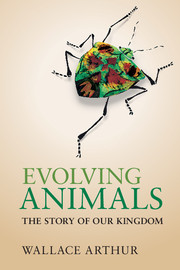Book contents
- Frontmatter
- Dedication
- Contents
- Preface
- Acknowledgements
- 1 What is an animal?
- 2 Before there were animals
- 3 How to make a fossil
- 4 The Cambrian explosion
- 5 How to make a species
- 6 Jellyfish and their kin
- 7 How to make a tree
- 8 The enigmatic urbilaterian
- 9 Animal symmetry and heads
- 10 A plethora of worms
- 11 Trends in animal complexity
- 12 Where the octopus is king
- 13 How to make an animal
- 14 Exoskeletons galore
- 15 Extinction
- 16 Mouth first, mouth second
- 17 Comparing embryos
- 18 Larvae, mouthparts and moulting
- 19 The animal toolkit
- 20 Vertebrate origins and evolution
- 21 From water to land to water
- 22 Variation and inheritance
- 23 Evolutionary novelties
- 24 Human origins and evolution
- 25 Animal plasticity
- 26 The nature of adaptation
- 27 The direction of evolution
- 28 Animal extremophiles
- 29 Extraterrestrial animals?
- 30 The ghost in the machine
- Appendix
- References
- Index
13 - How to make an animal
Published online by Cambridge University Press: 05 August 2014
- Frontmatter
- Dedication
- Contents
- Preface
- Acknowledgements
- 1 What is an animal?
- 2 Before there were animals
- 3 How to make a fossil
- 4 The Cambrian explosion
- 5 How to make a species
- 6 Jellyfish and their kin
- 7 How to make a tree
- 8 The enigmatic urbilaterian
- 9 Animal symmetry and heads
- 10 A plethora of worms
- 11 Trends in animal complexity
- 12 Where the octopus is king
- 13 How to make an animal
- 14 Exoskeletons galore
- 15 Extinction
- 16 Mouth first, mouth second
- 17 Comparing embryos
- 18 Larvae, mouthparts and moulting
- 19 The animal toolkit
- 20 Vertebrate origins and evolution
- 21 From water to land to water
- 22 Variation and inheritance
- 23 Evolutionary novelties
- 24 Human origins and evolution
- 25 Animal plasticity
- 26 The nature of adaptation
- 27 The direction of evolution
- 28 Animal extremophiles
- 29 Extraterrestrial animals?
- 30 The ghost in the machine
- Appendix
- References
- Index
Summary
Every animal gets made by two processes, which take very different lengths of time. The longer-term process is the one we’ve already been discussing in most chapters of the book: evolution. Here, a particular type of animal is made from a different, earlier-arising type by a series of modifications that rely on Darwinian natural selection and perhaps, as we’ll see later, on other things. The shorter-term process is the one we will now begin to address explicitly: development. Here, an animal is made from the starting point of (usually) a fertilized egg.
Although evolution and development work on very different timescales, they are inextricably linked. Each is, in a manner of speaking, the starting point for the other. To see this clearly, it helps to consider the whole of egg-to-adult development as a trajectory, or, to put it another way, as a route from a simple, unicellular beginning to a complex, multicellular end. Each type of animal has such a trajectory, though when animals with very different adult forms are compared, their developmental trajectories are found to be likewise very different (especially in their later stages). For example, although we have not looked at any developmental details yet, it is clear, to use the molluscs of the last chapter as an example, that a very different route must be taken from the fertilized egg to end up in one case with a snail and in another case with an octopus.
- Type
- Chapter
- Information
- Evolving AnimalsThe Story of our Kingdom, pp. 123 - 134Publisher: Cambridge University PressPrint publication year: 2014



